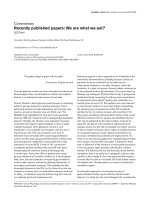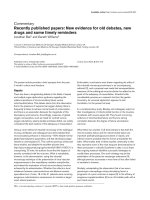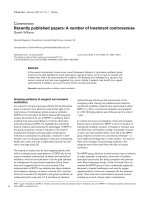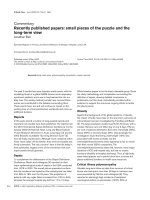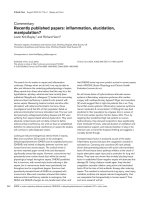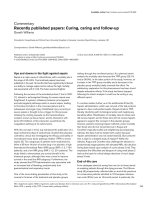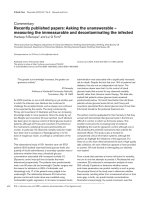Báo cáo y học: "Recently published papers: Pseudomonas, brain and bowel injury and novel cardiac therapies" ppsx
Bạn đang xem bản rút gọn của tài liệu. Xem và tải ngay bản đầy đủ của tài liệu tại đây (51.66 KB, 3 trang )
Page 1 of 3
(page number not for citation purposes)
Available online />Abstract
Ventilator-associated pneumonia is a familiar foe in intensive care
units, but those associated with Pseudomonas aeruginosa have a
particularly adverse impact on outcome. Correct antibiotic therapy
and a novel endotracheal tube may reduce this burden. Does
activated protein C improve outcome from acute lung injury and
what is the role played by hyperventilation therapy in traumatic
brain injury? Recent research has attempted to answer these
questions. Further novel approaches have been evaluated in the
management of ischaemic heart disease, and more light has been
shed on acute bowel injury.
Ventilator-associated pneumonia
Ventilator-associated pneumonia (VAP) is strongly associated
with adverse outcomes in mechanically ventilated patients in
the intensive care unit (ICU). Its incidence is about 8% to
20% [1] and mortality ranges between 20% and 50% [2].
Consequently, VAP has considerable impact on morbidity,
length of stay and cost of ICU care [3,4].
Kollef and coworkers [5] conducted a retrospective cohort
study involving 76 patients in an urban tertiary hospital who
were recruited over 5 years. The objective was to identify
predictors of 30-day mortality and hospital costs in patients
with VAP attributed to potentially antibiotic-resistant Gram-
negative bacteria (Pseudomonas aeruginosa, Acinetobacter
spp. and Stenotrophomonas maltophilia). Overall mortality
was 25%. Patients receiving their first dose of appropriate
antibiotic therapy within 24 hours of bronchoalveolar lavage
(BAL) sampling had a statistically lower 30-day mortality rate
and hospitalization cost as compared with patients receiving
their first dose of appropriate therapy more than 24 hours
after BAL (17.2% versus 50.0%). The authors conclude that
prompt (<24 hours) microbiological diagnosis and appro-
priate initial antimicrobial therapy produced healthier outcome
data; and that appropriate changes should be made to local
empirical antibiotic policies in VAP in the case of higher rates
of VAP due to antibiotic-resistant bacteria.
In a second report, El Solh and colleagues [6] suggested that
short-course (≤7 days) antimicrobial therapy may not be
adequate. The investigators studied the high mortality figures
in Pseudomonas VAP and evaluated causes of microbial
persistence in the alveolar space despite adequate anti-
microbial therapy. They hypothesized that failure to eradicate
P. aeruginosa from the lung is linked to type III secretory
system isolates (cytotoxins indicating virulence). Thirty-four
patients with P. aeruginosa VAP underwent noninvasive BAL
at the onset of VAP and on day 8 after initiation of antibiotic
therapy. Analysis for type III cytotoxins was undertaken and
results indicated that about 50% of the patients had
persistence of type III secretory system cytotoxins. The rest
had full eradication, with undetectable levels of the cytotoxins.
The persistence of the cytotoxins was attributed to the delay
to eradication of the micro-organisms, and hence the recom-
mendation is for longer courses of antimicrobial therapy.
Kollef and coworkers produced another report from the
NASCENT trial [7], which is a multicentre randomized single
blinded study including about 2,003 patients considered for
the trial. The primary outcome was the incidence VAP by
means of BAL fluid analysis at 24 hours. Patients were
assigned to undergo intubation with one of two high-volume,
low-pressure endotracheal tubes (ETTs), which were similar
except for a silver coating on the experimental tube. The
microbiologically confirmed rate of VAP in the treatment limb
was 4.8% and that in the conventional limb was 7.5%, with a
relative risk reduction of 35.9%. The investigators suggested
that patients receiving a silver-coated ETT had a statistically
significant reduction in the incidence of VAP and delayed
time to VAP occurrence as compared with those receiving a
similar, uncoated tube, although there was not much impact
Commentary
Recently published papers:
Pseudomonas
, brain and bowel
injury and novel cardiac therapies
Uma M Bandarupalli and Gareth Williams
University Hospitals of Leicester NHS Trust, Infirmary Square, Leicester LE1 5WW, UK
Corresponding author: Gareth Williams,
Published: 14 October 2008 Critical Care 2008, 12:184 (doi:10.1186/cc7019)
This article is online at />© 2008 BioMed Central Ltd
ALI = acute lung injury; APC = activated protein C; BAL = bronchoalveolar lavage; ETT = endotracheal tube; IAH = intra-abdominal hypertension;
IAP = intra-abdominal pressure; ICU = intensive care unit; TBI = traumatic brain injury; VAP = ventilator-associated pneumonia.
Page 2 of 3
(page number not for citation purposes)
Critical Care Vol 12 No 5 Williams and Bandarupalli
on length of stay and overall mortality. Does this provide a
rationale for using silver-lined ETTs in patients who are likely
to require ventilation for longer than 24 hours?
Finally, we examine another paper published in Critical Care
Medicine [8] dealing with outcome data from VAP patients
with high bacterial loads. The authors investigated the fre-
quency and outcomes of ventilated patients with newly
acquired, large-burden infection with P. aeruginosa. They also
verified the hypothesis that large bacterial loads were
associated with adverse outcomes. A total of 69 patients
were enrolled into the prospective study over a 4-year period
who required more than 48 hours of mechanical ventilation
and were identified as having newly acquired P. aeruginosa in
their lower respiratory tracts. Daily surveillance cultures of
endotracheal aspirates, Pseudomonas quantification and
clinical signs of infection were analyzed. The results make for
interesting reading. Forty-five out of 69 patients had high
Pseudomonas burdens, but about one-third of these did not
meet clinical criteria for VAP diagnosis but still had
statistically significant higher risk for death (adjusted hazard
ratio = 37.53) as compared with the patients who had
clinically diagnosed P. aeruginosa VAP. Furthermore, more
patients with high P. aeruginosa burdens secreted the type III
secretion facilitator protein PcrV, suggesting higher virulence.
Is it time to revisit the clinical criteria for VAP diagnosis, with
greater emphasis on quantification of respiratory tract
bacterial load?
Hyperventilation therapy after traumatic brain
injury
Neumann and coworkers reported data from the BrainIT
database concerning use of hyperventilation strategies and
adherence to Brain Trauma Foundation Guidelines after
traumatic brain injury (TBI) in intensive care medicine [9].
This was a retrospective study of monitoring data from 22
European centres and involved 151 patients. The latest
editions of the Brain Trauma Foundation Guidelines maintain
a restricted use of hyperventilation for the treatment of TBI
because of its negative impact on cerebral blood flow/
oxygenation and clinical outcome [10,11]. The study utilized
data from nearly 8,000 blood gas analyses, representing
ventilation episodes along with related minute by minute
intracranial pressure data. Episodes were studied as under
24 hours or over 24 hours since TBI. Results from the study
indicate that there was general adherence to guidelines
except in cases of early prophylactic hyperventilation and
cerebral oxygenation monitoring in forced hyperventilation.
The authors suggest that, in the absence of elevated
intracranial pressure, hyperventilation is better avoided; and
that intentional reduction in arterial carbon dioxide tension to
below 35 mmHg has little supporting evidence.
Acute lung injury
Use of activated protein C (APC) in severe sepsis following
the PROWESS and ADDRESS studies received a major
boost throughout the world in all major ICUs. APC is a
recognized adjunctive therapy in severe sepsis along with
best standard care. It has been widely accepted that plasma
protein C levels are low in patients with acute lung injury (ALI)
(even without sepsis), with higher mortality/morbidity figures
[12].
A report recently published in the American Journal of
Respiratory and Critical Care Medicine [13] examined the
efficacy of APC as a therapy for patients with ALI. American/
European consensus criteria for ALI were used to identify
suitable patients, and those with severe sepsis and an Acute
Physiology and Chronic Health Evaluation II score of 25 or
greater were excluded. The primary end-point was ventilator-
free days. Eligible patients were randomly assigned to either
receive APC or placebo (double blinded) within 72 hours.
The results revealed that the APC-treated group had
increased plasma protein C levels and decreased pulmonary
dead space fraction, but sadly this did not translate into
clinical benefit, there being no difference in the number of
ventilator-free days between the two groups. Hence, the
investigators concluded that APC did not improve outcomes
from ALI in the absence of severe sepsis and high disease
severity.
Current affairs in ischaemic heart disease
Results from BEAUTIFUL [14], a randomized, double-blind,
placebo-controlled trial evaluating the use of ivabradine for
patients with stable coronary artery disease and left
ventricular systolic dysfunction, were recently published in the
Lancet.
Ivabradine specifically inhibits the If current in the sinoatrial
node to lower heart rate. Fox and coworkers [14] exploited
this effect of the drug in more than 10,000 patients with
stable coronary artery disease and left ventricular ejection
fraction less than 40% recruited over 2 years. The primary
end-point was a composite of cardiovascular death, admis-
sion to hospital for acute myocardial infarction and admission
to hospital for new onset or worsening heart failure. The
results indicated that the drug did not improve primary end-
points but improved secondary end-points. The investigators
suggested that use of the drug in patients with higher heart
rates (more than 70 beats/minute) reduced the incidence of
coronary artery disease outcomes.
‘On-TIME 2’ data were also recently published in the Lancet
[15]. This was a multicentre, double-blind trial including 984
patients, who were randomly assigned to receive tirofiban
(GpIIb/IIIa inhibitor) and placebo. The primary end-point was
the extent of residual ST-segment deviation 1 hour after per-
cutaneous coronary intervention. The study identified signifi-
cant benefit from prehospital use of tirofiban in patients with
acute ST-segment elevation myocardial infarction undergoing
primary coronary angioplasty (percutaneous coronary inter-
vention).
Page 3 of 3
(page number not for citation purposes)
Acute bowel injury
Reintam and coworkers [16] reported findings from a study in
which they evaluated the differential impact of primary and
secondary intra-abdominal hypertension (IAH) on outcomes
in intensive care medicine. This was a prospective study of
257 mechanically ventilated patients deemed to be at con-
siderable risk for development of IAH. These patients under-
went repeated measurements of intra-abdominal pressure
(IAP) during their ICU stay and were followed up to 90-day
survival. The authors incorporated the new consensus
definitions recently established by the World Society of the
Abdominal Compartment Syndrome [17].
• IAH is sustained or repeated pathological elevation of IAP
to 12 mmHg or greater.
• Abdominal compartment syndrome is sustained IAP
above 20 mmHg along with a new organ dysfunction.
• Primary IAH is a condition associated with injury or
disease in the abdomino-pelvic region that frequently
requires early surgical or interventional radiological
intervention (for example, peritonitis, pancreatitis, bowel
disease, or abdominal trauma).
• ‘Secondary IAH’ refers to conditions that do not originate
from the abdomino-pelvic region (for example, sepsis/
shock, polytrauma, cardiopulmonary disease,
intoxications, or burns).
IAH developed in 95 patients (37.0%) with primary IAH
(n = 60) and secondary IAH (n = 35) [16]. Patients with
secondary IAH exhibited a significant increase in mean IAP
during the first 3 days, whereas IAP decreased in the patients
with primary IAH. The patients with IAH had a significantly
higher mortality compared with patients without the
syndrome. The authors concluded the following: secondary
IAH is less frequent, has a different time course and worse
outcome; IAH was an independent predictor of ICU adverse
outcome; and ICU patients with two or more risk factors
should undergo daily IAP measurement.
This study was accompanied by an excellent editorial review
[18] that highlighted the importance of understanding the
mechanism of injury in IAH/abdominal compartment
syndrome. The review also proposed the concept of acute
bowel injury and acute intestinal distress syndrome. Clearly,
much work needs to be done in this area.
Competing interests
The authors declare that they have no competing interests.
References
1. American Thoracic Society & Infectious Diseases Society of
America: Guidelines for the management of adults with hospi-
tal-acquired, ventilator-associated, and healthcare-associated
pneumonia. Am J Respir Crit Care Med 2005, 171:388-416.
2. Tejerina E, Frutos-Vivar F, Restrepo MI, Anzueto A, Abroug F,
Palizas F, González M, D’Empaire G, Apezteguía C, Esteban A,
Internacional Mechanical Ventilation Study Group: Incidence, risk
factors, and outcome of ventilator-associated pneumonia.
J Crit Care 2006, 21:56-65.
3. Rello J, Ollendorf DA, Oster G, Vera-Llonch M, Bellm L, Redman
R, Kollef MH, VAP Outcomes Scientific Advisory Group:
Epidemiology and outcomes of ventilator-associated pneu-
monia in a large US database. Chest 2002, 122:2115-2121.
4. Iregui M, Ward S, Sherman G, Fraser VJ, Kollef M: Clinical
importance of delays in the initiation of appropriate antibiotic
treatment for ventilator associated pneumonia. Chest 2002,
122:262-268.
5. Kollef KE, Schramm GE, Wills AR, Reichley RM, Micek ST, Kollef
MH: Predictors of 30-day mortality and hospital costs in
patients with ventilator-associated pneumonia attributed to
potentially antibiotic-resistant gram-negative bacteria. Chest
2008, 134:281-287.
6. El Solh AA, Akinnusi ME, Wiener-Kronish JP, Lynch SV, Pineda
LA, Szarpa K: Persistent infection with Pseudomonas aerugi-
nosa in ventilator-associated pneumonia. Am J Respir Crit
Care Med 2008, 178:513-519,
7. Kollef MH, Afessa B, Anzueto A, Veremakis C, Kerr KM, Margolis
BD, Craven DE, Roberts PR, Arroliga AC, Hubmayr RD, Restrepo
MI, Auger WR, Schinner R; NASCENT Investigation Group:
Silver-coated endotracheal tubes and incidence of ventilator-
associated pneumonia: the NASCENT randomized trial. JAMA
2008, 300:805-813
8. Zhuo H, Yang K, Lynch SV, Dotson RH, Glidden DV, Singh G,
Webb WR, Elicker BM, Garcia O, Brown R, Sawa Y, Misset B,
Wiener-Kronish JP: Increased mortality of ventilated patients
with endotracheal Pseudomonas aeruginosa without clinical
signs of infection. Crit Care Med 2008, 36:2495-2503.
9. Neumann JO, Chambers IR, Citerio G, Enblad P, Gregson PA,
Howells T, Mattern J, Nilsson P, Piper I, Ragauskas A, Sahuquillo
J, Yau YH, Kiening K: The use of hyperventilation therapy after
traumatic brain injury in Europe: an analysis of the BrainIT
database. Intensive Care Med 2008 34:9.
10. Bullock MR, Chesnut RM, Clifton GL, Ghajar J, Marion DW,
Narayan RK, Newell DW, Pitts LH, Rosner MJ, Walters BC,
Wilberger JE: Management and prognosis of severe traumatic
brain injury. Part I: guidelines for the management of severe
traumatic brain injury. J Neurotrauma 2000, 17:513-520.
11. Bullock MR, Povlishock JT: Guidelines for the management of
severe traumatic brain injury. J Neurotrauma 2007, 24(suppl
1):587-590.
12. Ware LB, Fang X, Matthay MA: Protein C and thrombomodulin
in human acute lung injury. Am J Physiol Lung Cell Mol Physiol
2003, 285:L514-L521.
13. Liu KD, Levitt J, Zhuo H, Kallet RH, Brady S, Steingrub J, Tidswell
M, Siegel MD, Soto G, Peterson MW, Chesnutt MS, Phillips C,
Weinacker A, Thompson BT, Eisner MD, Matthay MA: Random-
ized clinical trial of activated protein C for the treatment of
acute lung injury. Am J Respir Crit Care Med 2008, 178:
618-
623.
14. Fox K, Ford I, Steg PG, Tendera M, Ferrari R; BEAUTIFUL Investi-
gators: Ivabradine for patients with stable coronary artery
disease and left-ventricular systolic dysfunction (BEAUTIFUL):
a randomised, double-blind, placebo-controlled trial. Lancet
2008, 372:807-816.
15. Van’t Hof AW, Ten Berg J, Heestermans T, Dill T, Funck RC, van
Werkum W, Dambrink JH, Suryapranata H, van Houwelingen G,
Ottervanger JP, Stella P, Giannitsis E, Hamm C; Ongoing
Tirofiban In Myocardial infarction Evaluation (On-TIME) 2 study
group: Prehospital initiation of tirofiban in patients with ST-
elevation myocardial infarction undergoing primary angio-
plasty (On-TIME 2): a multicentre, double-blind, randomised
controlled trial. Lancet 2008, 372:537-546.
16. Reintam A, Parm P, Kitus R, Kern H, Starkopf J: Primary and sec-
ondary intra-abdominal hypertension different impact on ICU
outcome. Intensive Care Med 2008, 34:9.
17. World Society of the Abdominal Compartment Syndrome
Consensus Guidelines Summary [ />sensus_summary.php]
18. Malbrain ML, De Laet I: AIDS is coming to your ICU: be pre-
pared for acute bowel injury and acute intestinal distress syn-
drome. Intensive Care Med 2008, 34:1565-1569.
Available online />

